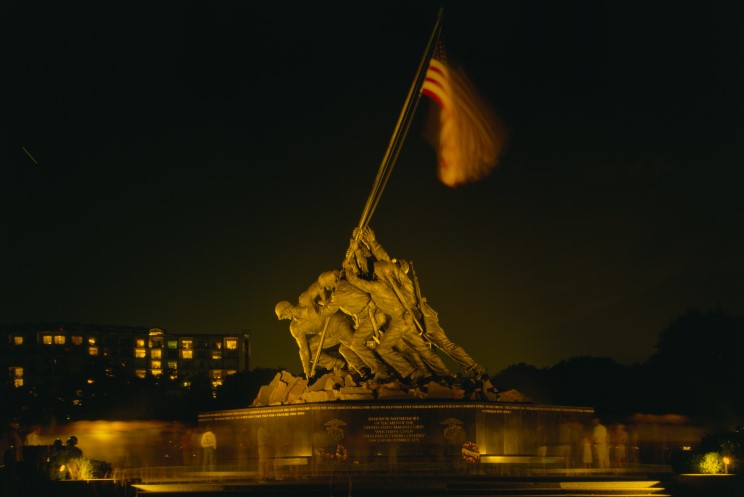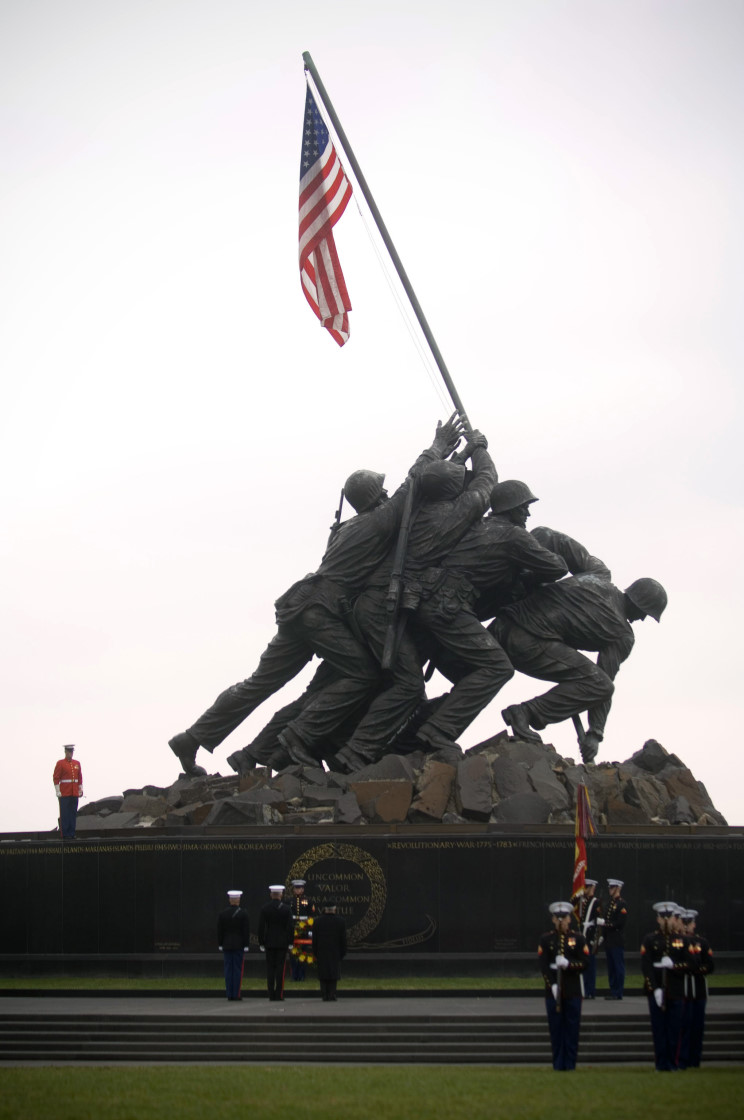U.S. Marine Corps War Memorial |
|
Arlington, Virginia |
 |
The U.S. Marine Corps War Memorial in Arlington, Virginia.
|
 |
November 10, 2007: U.S. Marines conduct a wreath laying ceremony in honor of the 232nd Marine Corps birthday at the U.S. Marine Corps War memorial.
|
The Marine Corps War Memorial stands as a symbol of this grateful Nation's esteem for the honored dead of the U.S. Marine Corps. While the statue depicts one of the most famous incidents of World War II, the memorial is dedicated to all Marines who have given their lives in the defense of the United States since 1775.
The small island of Iwo Jima lies 660 miles south of Tokyo. One of its outstanding geographical features is Mount Suribachi, an extinct volcano that forms the narrow southern tip of the island and rises 550 feet to dominate the area. By February 1945, U.S. troops had recaptured most of the territory taken by the Japanese in 1941 and 1942; still uncaptured was Iwo Jima, which became a primary objective in American plans to bring the Pacific campaign to a successful conclusion. On the morning of February 19, 1945, the 4th and 5th Marine Divisions invaded Iwo Jima after a somewhat ineffective bombardment lasting 72 hours. The 28th Regiment, 5th Division, was ordered to capture Mount Suribachi. They reached the base of the mountain on the afternoon of February 21, and by nightfall the next day had almost completely surrounded it. On the morning of February 23, Marines of Company E, 2nd Battalion, started the tortuous climb up the rough terrain to the top. At about 10:30 a.m., men all over the island were thrilled by the sight of a small American flag flying from atop Mount Suribachi. That afternoon, when the slopes were clear of enemy resistance, a second, larger flag was raised by five Marines and a Navy hospital corpsman: Sgt. Michael Strank, Cpl. Harlon H. Block, Pfc. Franklin R. Sousley, Pfc. Rene A. Gagnon, Pfc. Ira Hayes, and PhM. 2/c John H. Bradley, USN. News-photographer Joe Rosenthal caught the afternoon flag raising in an inspiring Pulitzer Prize winning photograph. When the picture was later released, sculptor Felix W. de Weldon, then on duty with the U.S. Navy, was so moved by the scene that he constructed a scale model and then a life-size model of it. Gagnon, Hayes, and Bradley, the three survivors of the flag raising (the others having been killed in later phases of the Iwo Jima battle), posed for the sculptor who modeled their faces in clay. All available pictures and physical statistics of the three who had given their lives were collected and then used in the modeling of their faces. Once the statue was completed in plaster, it was carefully disassembled and trucked to Brooklyn, N.Y., for casting in bronze. The casting process, which required the work of experienced artisans, took nearly 3 years. After the parts had been cast, cleaned, finished, and chased, they were reassembled into approximately a dozen pieces--the largest weighing more than 20 tons--and brought back to Washington, D.C., by a three truck convoy. Here they were bolted and welded together, and the statue was treated with preservatives. Erection of the memorial, which was designed by Horace W. Peaslee, was begun in September 1954. It was officially dedicated by President Dwight D. Eisenhower on November 10, 1954, the 179th anniversary of the U.S. Marine Corps. Memorial Statistics The 32-foot-high figures are shown erecting a 60-foot bronze flagpole from which a cloth flag flies 24 hours a day in accordance with Presidential proclamation of June 12, 1961. They occupy the same positions as in Rosenthal's historic photograph. Hayes is the figure farthest from the flag staff; Sousley to the right front of Hayes; Strank on Sousley's left; Bradley in front of Sousley; Gagnon in front of Strank; and Block closest to the bottom of the flagstaff. The figures, placed on a rock slope, rise about 6 feet from a 10-foot base, making the memorial 78 feet high overall. The M-l rifle and the carbine carried by two of the figures are 16 and 12 feet long, respectively. The canteen would hold 32 quarts of water. The base of the memorial is made of rough Swedish granite. Burnished in gold on the granite are the names and dates of every principal Marine Corps engagement since the founding of the Corps, as well as the inscription: "In honor and in memory of the men of the United States Marine Corps who have given their lives to their country since November 10, 1775." Also inscribed on the base is the tribute of Fleet Adm. Chester W. Nimitz to the fighting men on Iwo Jima: "Uncommon Valor was a Common Virtue." The entire cost of the statue and developing the memorial site was $850,000--all donated by U.S. Marines, former Marines, Marine Corps Reservists, friends of the Marine Corps, and members of the Naval Service. No public funds were used for this memorial. |
(Text courtesy of the National Park Service)
|
Page published Nov. 1, 2009 |